Page 4126 of 4264

7A2-134 DIAGNOSIS (JR405E)
No. I1: No Lock-up
Description:
� Lockup is not performed in spite of the lock-up area.
Diagnosis:
� Lockup is not performed in spite of the lock-up area.
� Monitor the signal to the lock-up solenoid while carrying out a running test.
� When the output signal to the lock-up solenoid is correctly sent causing no lock-up, clogged lock-up solenoid oil
passage or malfunction of the lock-up piston may be considered.
� Even the lock-up area, the output signal to the lock-up solenoid is not sent, fault of the ATF thermo sensor
controlling the lockup is considered. (Lock-up is not operated at ATF temperature less than 11�C or more than
128�C.)
Note:
When the lock-up piston has burnt, foreign material mixed in the oil cooler is considered. In such a
case, inspect the oil cooler circuit for clogging of the oil cooler
Possible Cause:
� ATF thermo sensor detects low oil temperature (Lock-up is prohibited temperature less than 10�C.).
� Clogged oil passage of lock-up duty solenoid.
� Trouble in control valve body (faulty operation, sticking, clogged oil passage).
Step Action Yes No
1 Are any DTCs stored?
Go to DTC Chart Go to Step 2
2 Are the quantity, contamination and smell normal?
If the ATF level is
low, replenish up to
the specified level.
Go to Step 3
If ATF is extremely
black and
contaminated and
smells burnt, slip of
the clutch is
supposed.
Overhaul the AT
unit.
Page 4127 of 4264
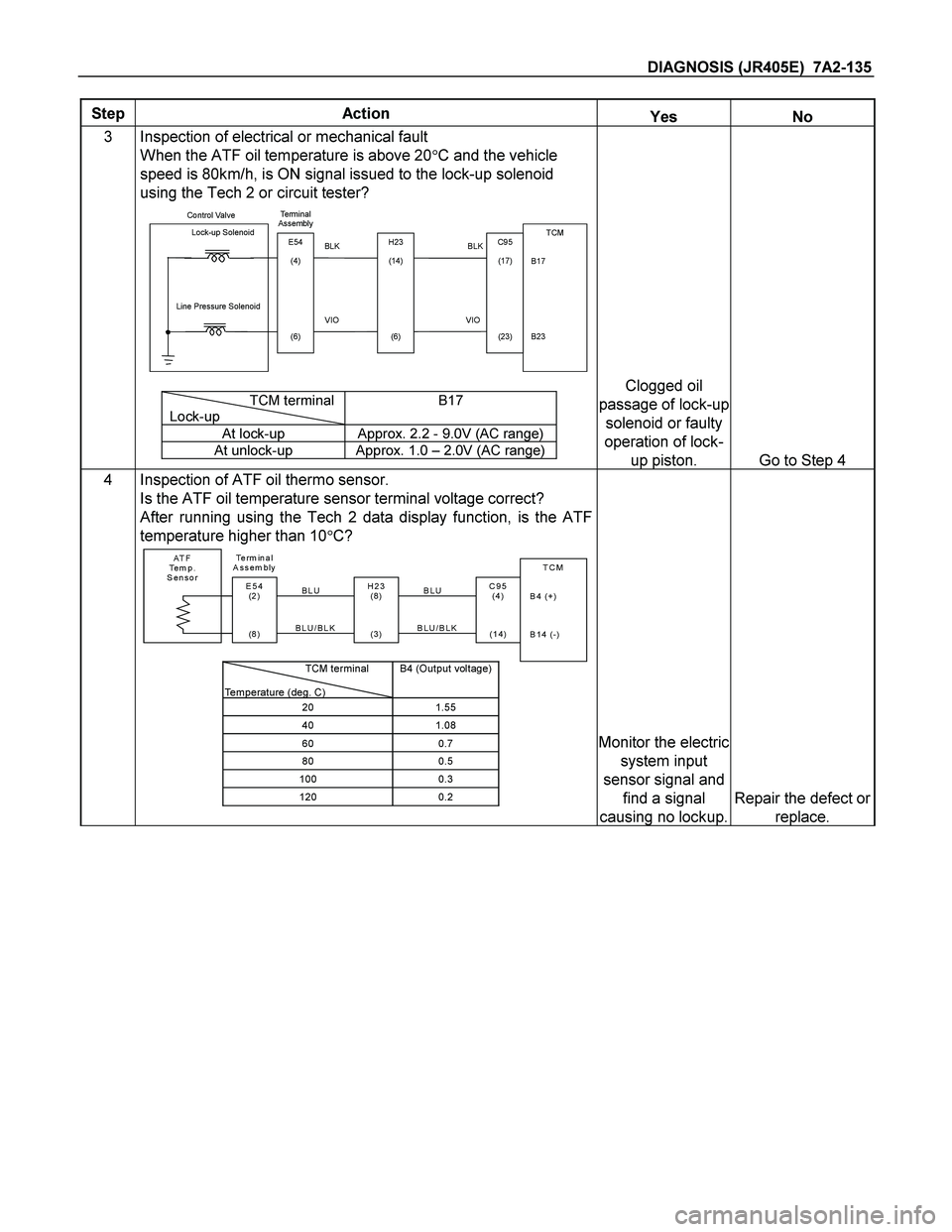
DIAGNOSIS (JR405E) 7A2-135
Step Action Yes No
3 Inspection of electrical or mechanical fault
When the ATF oil temperature is above 20�C and the vehicle
speed is 80km/h, is ON signal issued to the lock-up solenoid
using the Tech 2 or circuit tester?
Control Valve
TCM
B17
B23 BLK Lock-up Solenoid
Terminal
Assembly
VIO Line Pressure Solenoid
E54
(4)
(6)H23
(14)
(6)C95
(17)
(23) BLK
VIO
TCM terminal
Lock-upB17
At lock-up Approx. 2.2 - 9.0V (AC range)
At unlock-up Approx. 1.0 – 2.0V (AC range)
Clogged oil
passage of lock-up
solenoid or faulty
operation of lock-
up piston. Go to Step 4
4 Inspection of ATF oil thermo sensor.
Is the ATF oil temperature sensor terminal voltage correct?
After running using the Tech 2 data display function, is the ATF
temperature higher than 10�C?
AT F
Te m p .
SensorTCM
B4 (+)
B14 (-)
H23
(8)
(3)C95
(4)
(1 4) BLU Te r m in a l
Assembly
BLU/BLKE54
(2)
(8) BLU
BLU/BLK
TCM terminal
Temperature (deg. C)
B4 (Output voltage)
201.55
401.08
600.7
800.5
1000.3
1200.2
Monitor the electric
system input
sensor signal and
find a signal
causing no lockup.
Repair the defect or
replace.
Page 4128 of 4264
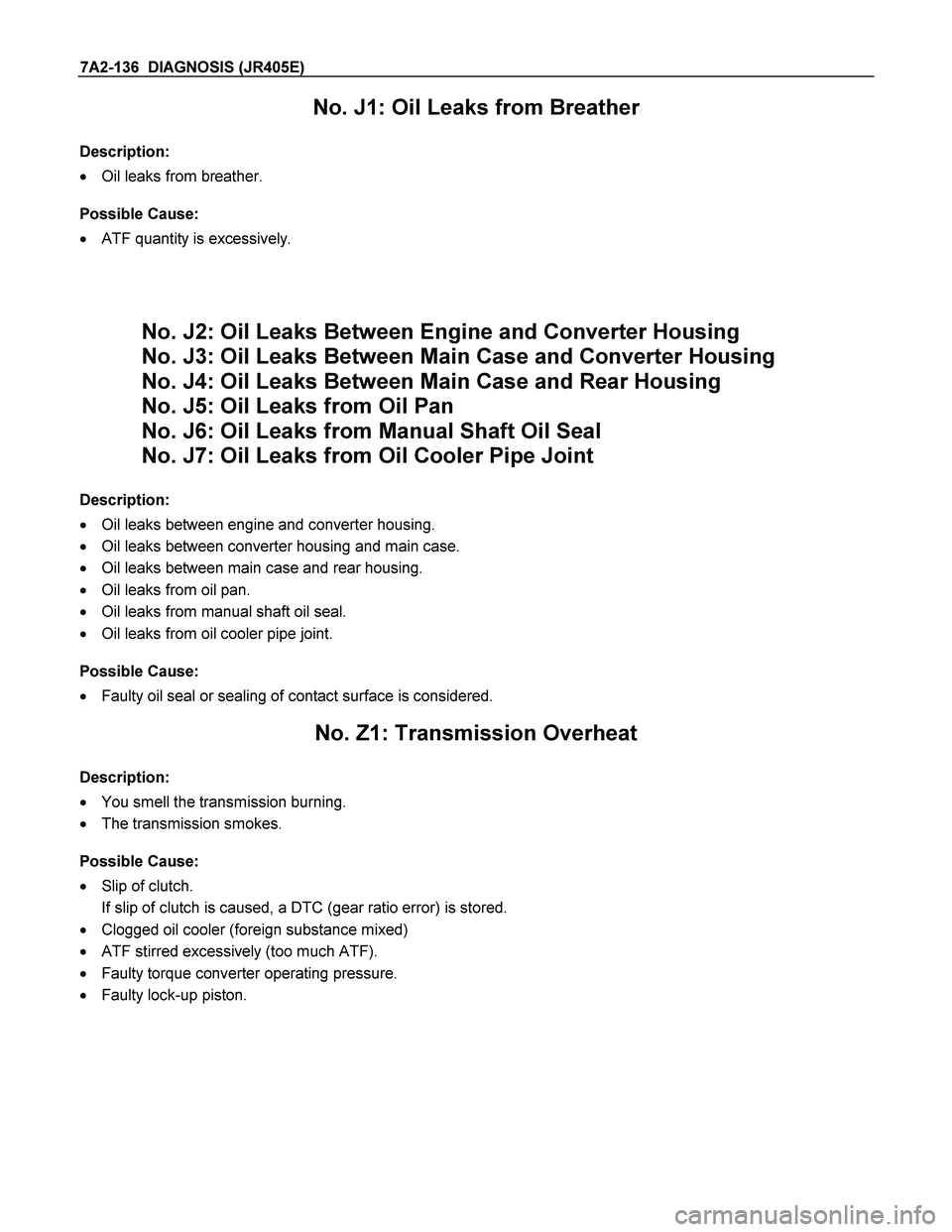
7A2-136 DIAGNOSIS (JR405E)
No. J1: Oil Leaks from Breather
Description:
� Oil leaks from breather.
Possible Cause:
� ATF quantity is excessively.
No. J2: Oil Leaks Between Engine and Converter Housing
No. J3: Oil Leaks Between Main Case and Converter Housing
No. J4: Oil Leaks Between Main Case and Rear Housing
No. J5: Oil Leaks from Oil Pan
No. J6: Oil Leaks from Manual Shaft Oil Seal
No. J7: Oil Leaks from Oil Cooler Pipe Joint
Description:
� Oil leaks between engine and converter housing.
� Oil leaks between converter housing and main case.
� Oil leaks between main case and rear housing.
� Oil leaks from oil pan.
� Oil leaks from manual shaft oil seal.
� Oil leaks from oil cooler pipe joint.
Possible Cause:
� Faulty oil seal or sealing of contact surface is considered.
No. Z1: Transmission Overheat
Description:
� You smell the transmission burning.
� The transmission smokes.
Possible Cause:
� Slip of clutch.
If slip of clutch is caused, a DTC (gear ratio error) is stored.
� Clogged oil cooler (foreign substance mixed)
� ATF stirred excessively (too much ATF).
� Faulty torque converter operating pressure.
� Faulty lock-up piston.
Page 4129 of 4264
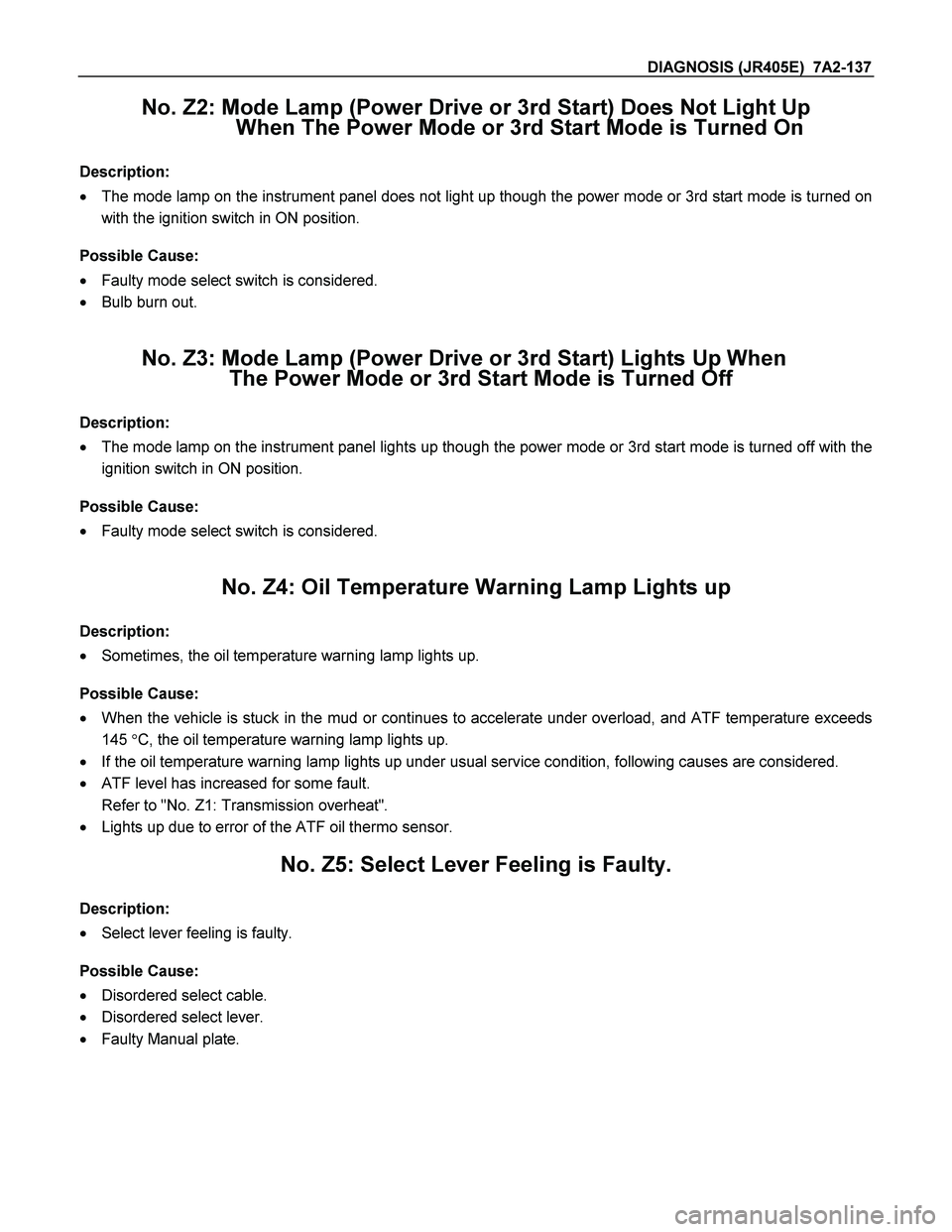
DIAGNOSIS (JR405E) 7A2-137
No. Z2: Mode Lamp (Power Drive or 3rd Start) Does Not Light Up
When The Power Mode or 3rd Start Mode is Turned On
Description:
� The mode lamp on the instrument panel does not light up though the power mode or 3rd start mode is turned on
with the ignition switch in ON position.
Possible Cause:
� Faulty mode select switch is considered.
� Bulb burn out.
No. Z3: Mode Lamp (Power Drive or 3rd Start) Lights Up When
The Power Mode or 3rd Start Mode is Turned Off
Description:
� The mode lamp on the instrument panel lights up though the power mode or 3rd start mode is turned off with the
ignition switch in ON position.
Possible Cause:
� Faulty mode select switch is considered.
No. Z4: Oil Temperature Warning Lamp Lights up
Description:
� Sometimes, the oil temperature warning lamp lights up.
Possible Cause:
� When the vehicle is stuck in the mud or continues to accelerate under overload, and ATF temperature exceeds
145 �C, the oil temperature warning lamp lights up.
� If the oil temperature warning lamp lights up under usual service condition, following causes are considered.
� ATF level has increased for some fault.
Refer to "No. Z1: Transmission overheat".
� Lights up due to error of the ATF oil thermo sensor.
No. Z5: Select Lever Feeling is Faulty.
Description:
� Select lever feeling is faulty.
Possible Cause:
� Disordered select cable.
� Disordered select lever.
� Faulty Manual plate.
Page 4130 of 4264
7A2-138 DIAGNOSIS (JR405E)
No. Z6: Poor Fuel Consumption
Description:
� Poor fuel consumption.
Diagnosis Hints:
� Basically same causes as "No. C1 - C8: Engine races up (slip) by shift up or shift down" are considered.
No. Z7: Pattern Select Switch is Faulty
Description:
� Shift pattern does not change though the pattern select switch is turned on.
Possible Cause:
� Faulty mode select switch is considered.
No. Z8: Oil is Splashed During the Running
Description:
� Oil is splashed during the running
Possible Cause:
� ATF quantity is too high.
No. Z9: Abnormal Smell
Description:
� Abnormal smell.
Diagnosis Hints:
� Basically a trouble in the AT main unit.
No. Z10: ATF Quantity is Low or High
Description:
� Oil quantity is low or high.
Possible Cause:
� In case of oil level is high.
ATF temperature is low when ATF quantity is checked.
� In case of oil level is low.
ATF leaks is considered. Check the AT main unit and cooler circuit.
Page 4131 of 4264
DIAGNOSIS (JR405E) 7A2-139
No. Z11: Abnormal Oil Pressure
Description:
� Oil pressure is low or high.
Possible Cause:
� Basically, the same cause as "No. C1 - C8: Engine races up (slip) by shift up or shift down" is considered.
� In case of oil pressure is low, faulty oil pump is considered.
No. Z12: Reverse Buzzer Does Not Ring
Description:
� Reverse buzzer does not ring in R range.
Possible Cause:
� Disordered select cable.
� Disordered select lever.
� Disordered inhibitor switch.
Page 4132 of 4264
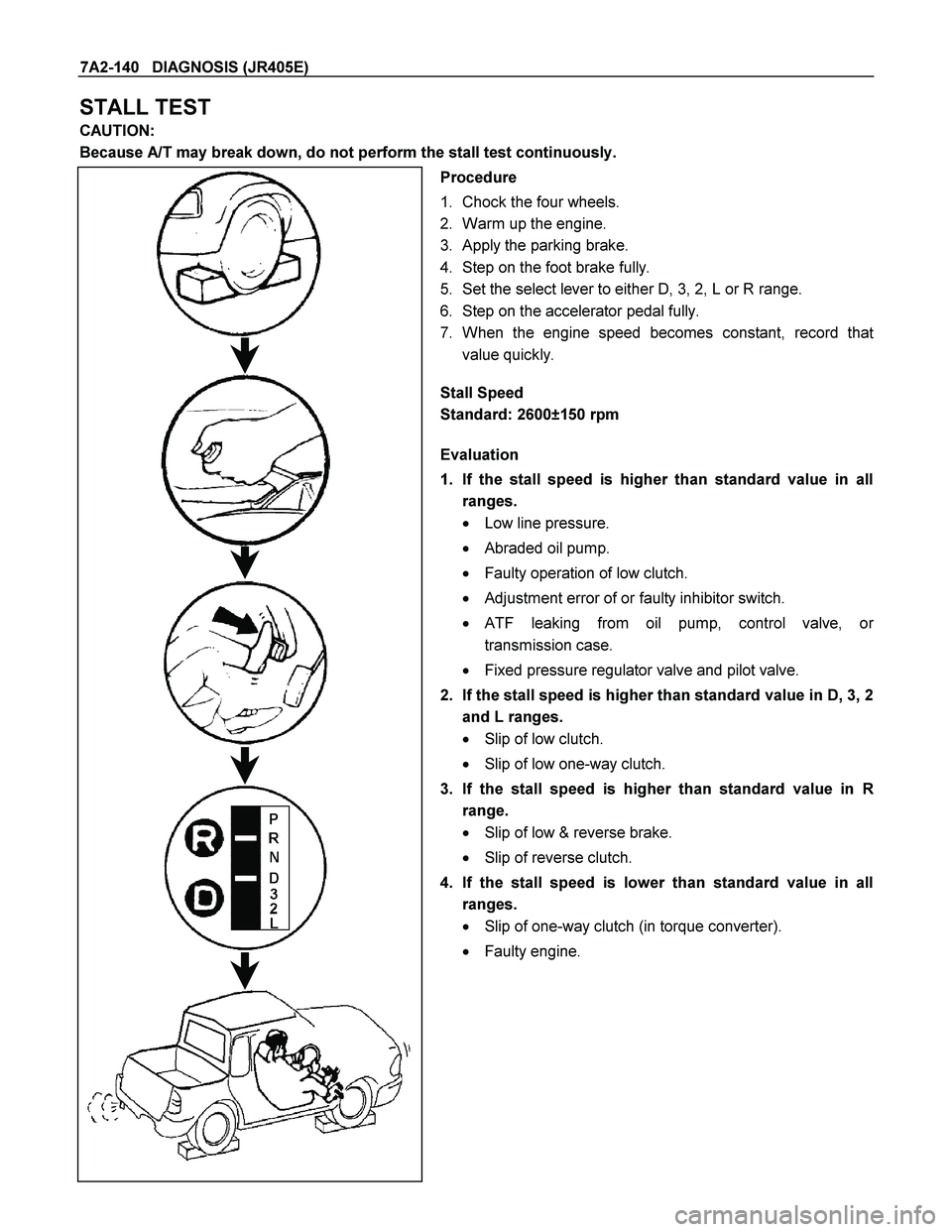
7A2-140 DIAGNOSIS (JR405E)
STALL TEST
CAUTION:
Because A/T may break down, do not perform the stall test continuously.
Procedure
1. Chock the four wheels.
2. Warm up the engine.
3. Apply the parking brake.
4. Step on the foot brake fully.
5. Set the select lever to either D, 3, 2, L or R range.
6. Step on the accelerator pedal fully.
7. When the engine speed becomes constant, record tha
t
value quickly.
Stall Speed
Standard: 2600±150 rpm
Evaluation
1. If the stall speed is higher than standard value in all
ranges.
� Low line pressure.
� Abraded oil pump.
� Faulty operation of low clutch.
� Adjustment error of or faulty inhibitor switch.
�
ATF leaking from oil pump, control valve, or
transmission case.
� Fixed pressure regulator valve and pilot valve.
2. If the stall speed is higher than standard value in D, 3, 2
and L ranges.
� Slip of low clutch.
� Slip of low one-way clutch.
3. If the stall speed is higher than standard value in
R
range.
� Slip of low & reverse brake.
� Slip of reverse clutch.
4. If the stall speed is lower than standard value in all
ranges.
� Slip of one-way clutch (in torque converter).
� Faulty engine.
Page 4133 of 4264
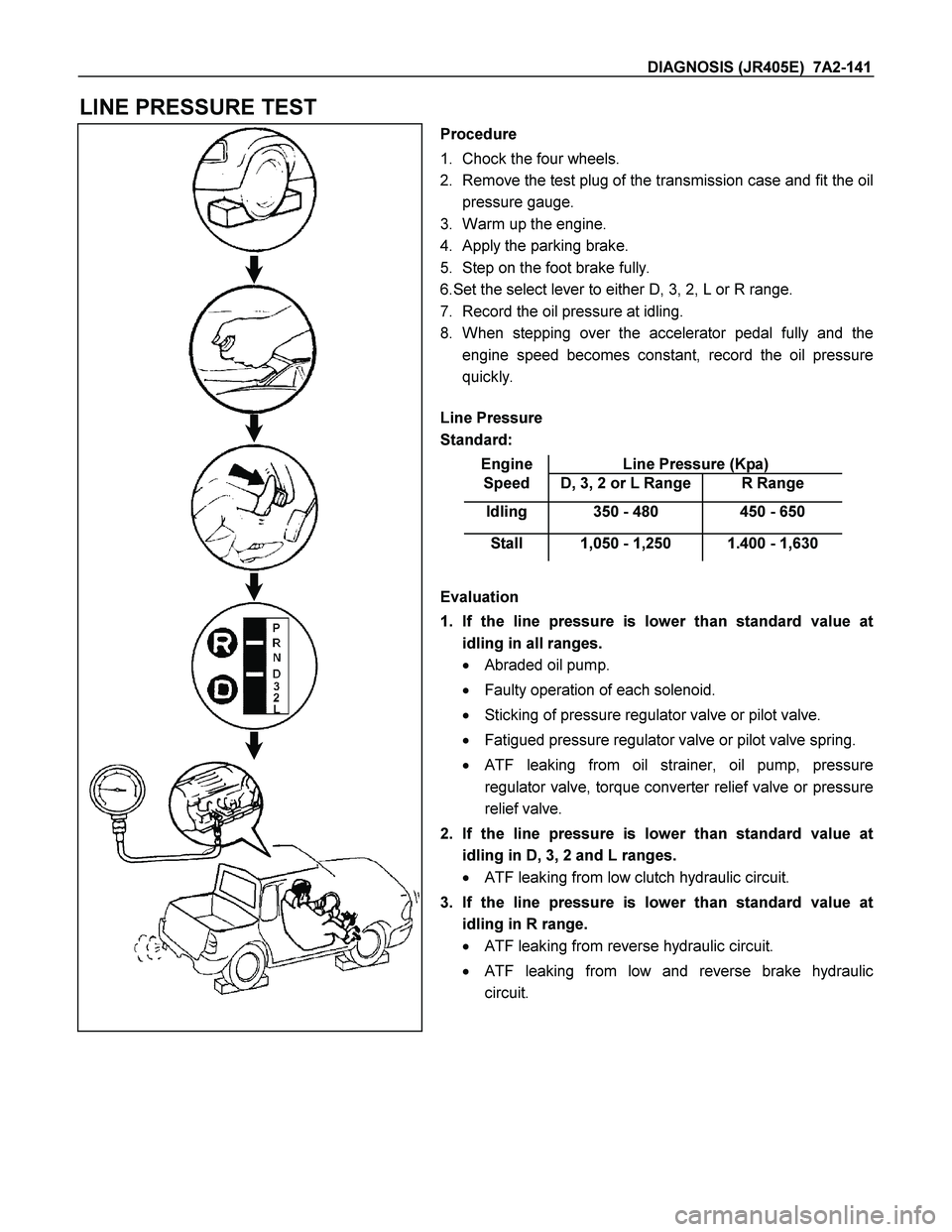
DIAGNOSIS (JR405E) 7A2-141
LINE PRESSURE TEST
Procedure
1. Chock the four wheels.
2. Remove the test plug of the transmission case and fit the oil
pressure gauge.
3. Warm up the engine.
4. Apply the parking brake.
5. Step on the foot brake fully.
6.Set the select lever to either D, 3, 2, L or R range.
7. Record the oil pressure at idling.
8. When stepping over the accelerator pedal fully and the
engine speed becomes constant, record the oil pressure
quickly.
Line Pressure
Standard:
Engine Line Pressure (Kpa)
Speed D, 3, 2 or L Range R Range
Idling 350 - 480 450 - 650
Stall 1,050 - 1,250 1.400 - 1,630
Evaluation
1. If the line pressure is lower than standard value at
idling in all ranges.
� Abraded oil pump.
� Faulty operation of each solenoid.
� Sticking of pressure regulator valve or pilot valve.
� Fatigued pressure regulator valve or pilot valve spring.
�
ATF leaking from oil strainer, oil pump, pressure
regulator valve, torque converter relief valve or pressure
relief valve.
2. If the line pressure is lower than standard value at
idling in D, 3, 2 and L ranges.
� ATF leaking from low clutch hydraulic circuit.
3. If the line pressure is lower than standard value at
idling in R range.
� ATF leaking from reverse hydraulic circuit.
� ATF leaking from low and reverse brake hydraulic
circuit.